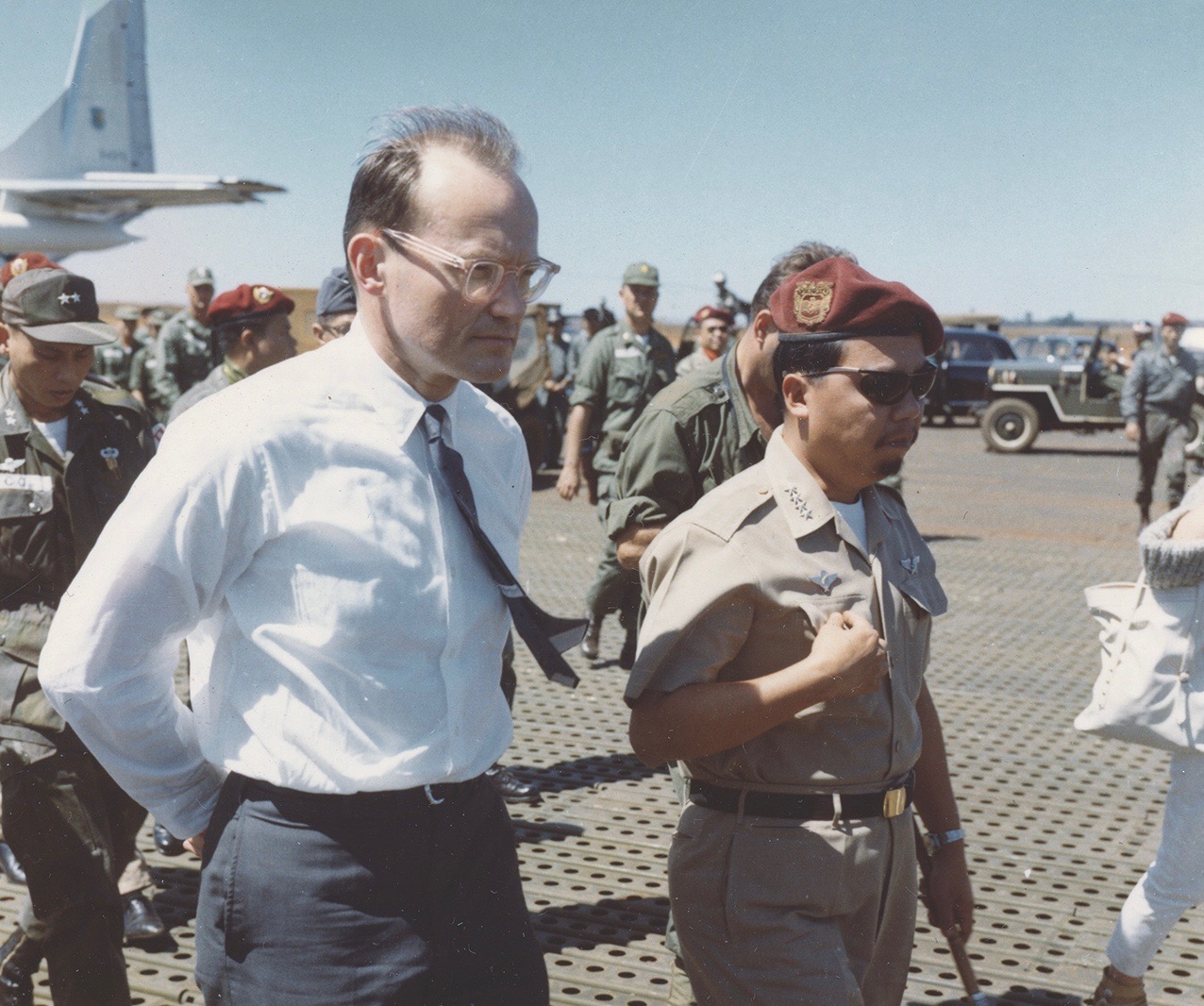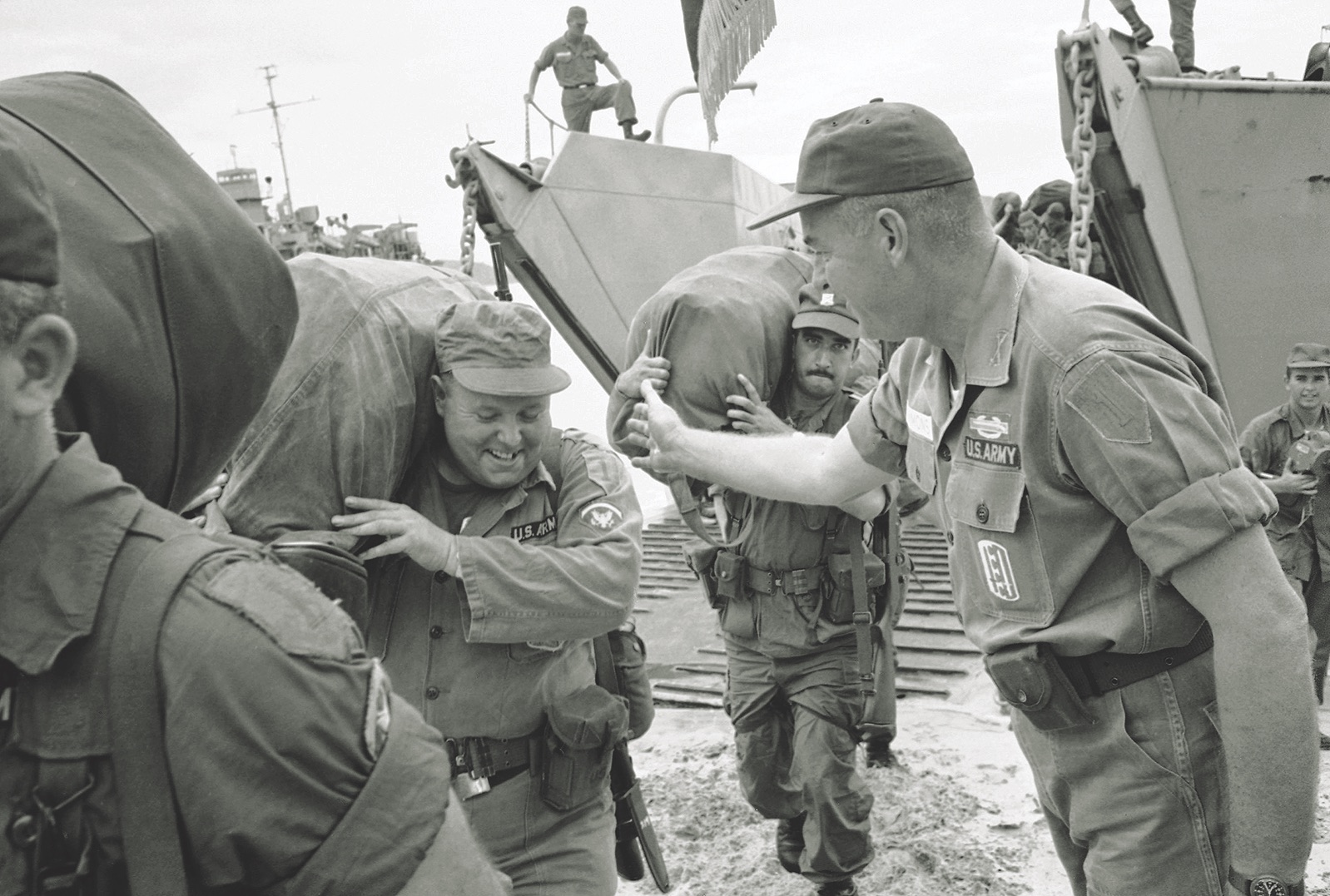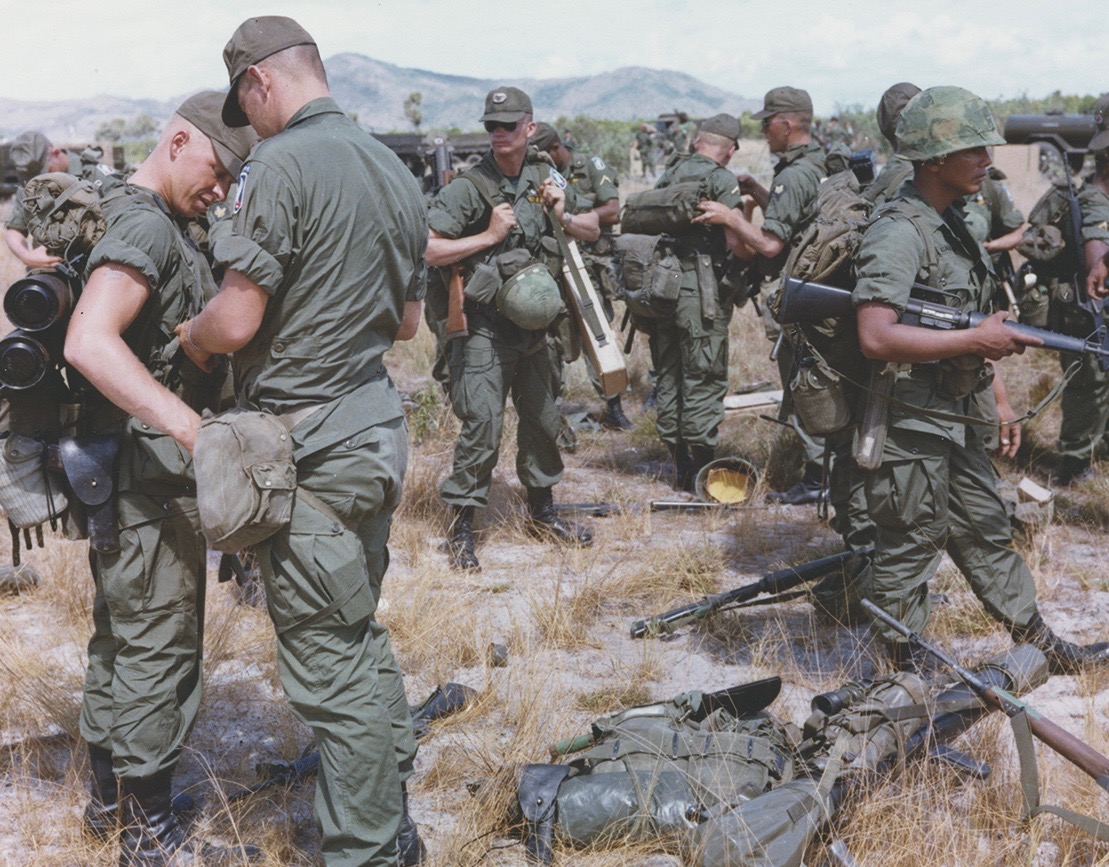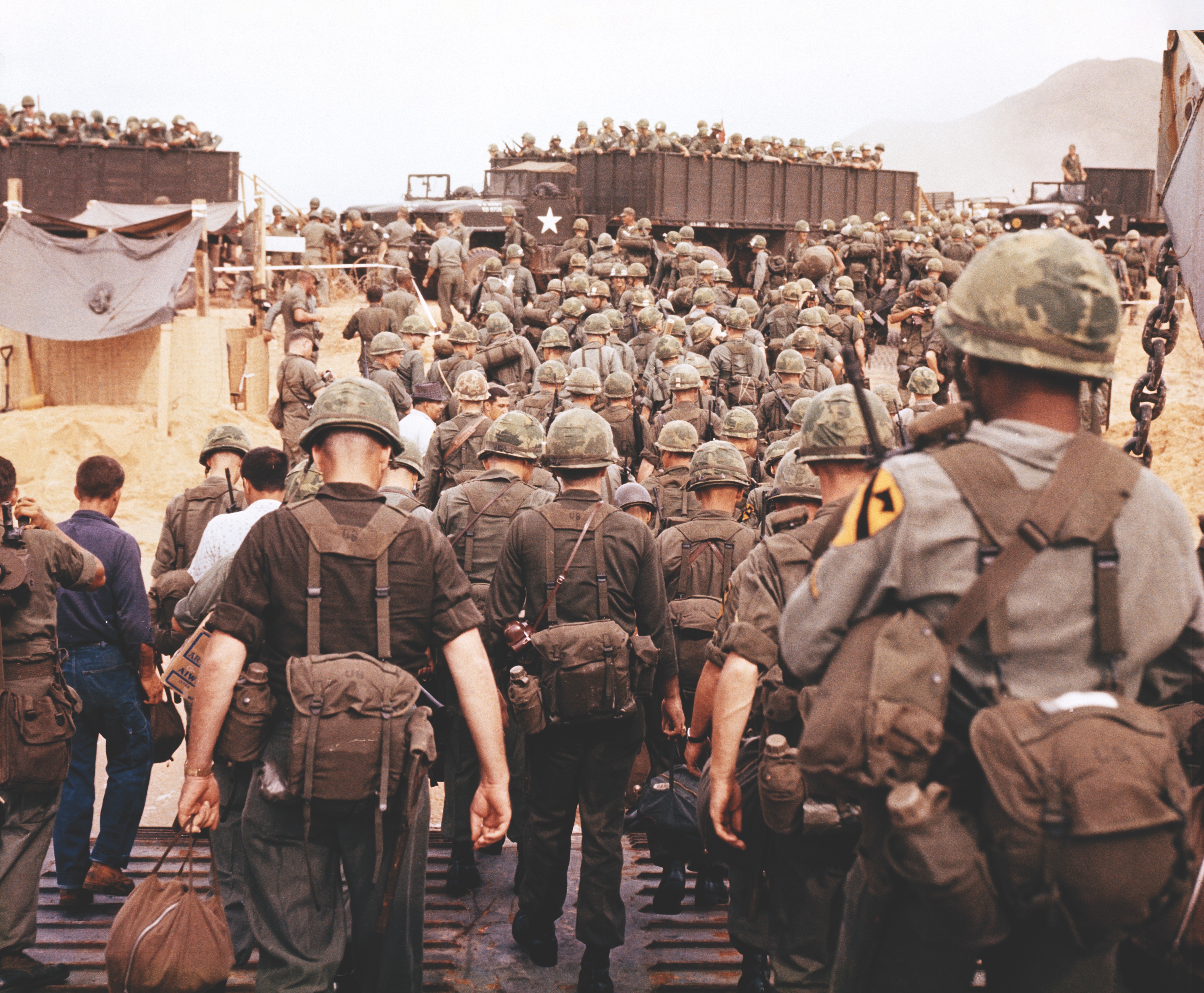The first troops sent to Vietnam had to battle personnel and equipment shortages.
When a soldier asked Secretary of Defense Donald Rumsfeld on Dec. 8, 2004, why his unit had not deployed to Iraq with more armor, Rumsfeld replied: “You go to war with the army you have, not the army you might want or wish to have at a later time.” The secretary’s response was characterized in the press as flippant and insensitive, but four decades earlier his comment would have been right on the mark as the first U.S. Army combat forces went into Vietnam during a massive American buildup in 1965, beginning with the March deployment of a Marine brigade.
The Army’s follow-on wave of three brigades and the 1st Cavalry Division (Airmobile) experienced serious personnel shortfalls, equipment shortages and training deficiencies. It was an army that neither policymakers nor soldiers wanted, but it was the army the United States had at the time.
As 1964 wound down, U.S. officials were confronted with a deteriorating military and political situation in Vietnam. Incumbent President Lyndon B. Johnson, a Democrat campaigning on a pledge not to send American boys “to do what Asian boys ought to be doing for themselves,” walloped Republican Senator Barry Goldwater of Arizona, carrying 44 states and amassing 61 percent of the popular vote. Notwithstanding his campaign rhetoric, Johnson was determined not to be the president who “lost Vietnam.” He remembered how conservative foes castigated Harry Truman in 1949 for “losing China” when Mao Zedong’s communists overwhelmed Chiang Kai-shek’s Nationalist forces. Johnson couldn’t afford a similar loss on his watch.
After his January 1965 inauguration, Johnson dispatched national security adviser McGeorge Bundy to Saigon to confer with U.S. Ambassador Maxwell Taylor and the top military leader there, Gen. William Westmoreland, commander of Military Assistance Command, Vietnam, to examine political and military options to ensure that South Vietnam would not collapse.
During Bundy’s visit Viet Cong commandos attacked the U.S. base at Pleiku in South Vietnam’s Central Highlands on Feb. 7, 1965, killing nine Americans, wounding 108 and destroying 21 aircraft. After surveying the damage and visiting wounded soldiers, Bundy became a vocal advocate of retaliation against North Vietnam and intervention to assist South Vietnam. His attitude hardened when the enemy attacked a barracks in the coastal city of Qui Nhon, on Feb. 10, killing 23 Americans and wounding 21.
The Johnson administration responded with Operation Rolling Thunder, a “controlled escalation” of air attacks on carefully selected North Vietnamese targets, and the president approved a request by Westmoreland for two Marine battalions to protect the U.S. airfield at Da Nang. On March 8, Marines under command of the 9th Marine Expeditionary Brigade landed at Da Nang.
After a March 1965 fact-finding trip, Gen. Harold K. Johnson, the U.S. Army chief of staff, announced, “It is in the interest of the United States to commit ground troops to Asia.” The general’s recommendation and Bundy’s advice, echoed by others, had a strong impact on Johnson, resulting in plans for additional combat forces in South Vietnam.

The president approved a target of 44 infantry battalions for deployment to Vietnam by the end of 1965. The Army and Marine Corps would furnish most of them. Johnson was told that his goal would require 180,000 U.S. personnel. Not wanting an unpopular military buildup to distract from his Great Society civil rights and anti-poverty programs, Johnson opted for a gradual, incremental increase in forces. He specifically rejected the recommendation for partial mobilization of the National Guard and Reserves, thereby shifting the entire combat burden to active-duty troops.
A full-court diplomatic press was put on America’s allies in the Southeast Asia Treaty Organization (an Asia-Pacific version of Europe’s NATO) to contribute to the 44-battalion target and enhance the perception that the buildup was part of an international coalition. South Korea was initially persuaded to send a reinforced division with nine infantry battalions while the Australian government reluctantly offered a single battalion. New Zealand, the Philippines and Thailand furnished much smaller numbers.
When Johnson gave his OK to introduce U.S. Army combat troops to Vietnam, the 173rd Airborne Brigade was the first to go, ordered to provide security for Bien Hoa Air Base, 12 miles northeast of Saigon. Stationed in Okinawa, Japan, the 173rd Airborne was the Pacific area’s “fire brigade,” prepared to respond to any crises in the region. Its maneuver forces were two airborne infantry battalions, the 1st and 2nd battalions of the 503rd Infantry Regiment, and an armored cavalry unit, E Troop, 17th Cavalry Regiment, supported by the 3rd Battalion, 319th Field Artillery Regiment.
Because of the brigade’s responsibilities in the Pacific, Brig. Gen. Ellis W. Williamson, the unit’s commander, already had Vietnam on his radar and had developed contingency plans, including training focused on counterinsurgency missions. Once the buildup was initiated, the 173rd Airborne received priority in the Army’s replacements and equipment requisitions.
A status report prepared for MACV stated that the 173rd Airborne Brigade was ready and in “the best possible equipment posture.” Williamson’s unit, however, was 10 percent understrength—161 officers and 2,816 enlisted men out of an authorization of more than 3,300. The bulk of the brigade moved to Bien Hoa Air Base and established positions facing nearby War Zone D, an area with a heavy concentration of Viet Cong forces, but the 1st Battalion, 503rd Infantry, was temporarily detached to provide security for the port facilities and airfield at Vung Tau, 60 miles southeast of the capital. To increase the brigade’s combat power, MACV attached the 1st Battalion of the Royal Australian Regiment and a New Zealand artillery battery.
Official pronouncements touting the strength of the 173rd Airborne differed from perspectives in the trenches, where shortages were in abundance, although that was nothing new.
“When I reported to 1st Battalion, 503rd Infantry, in November 1964, my platoon had 17 men present for duty,” recalled 2nd Lt. Robert M. “Bob” Gregson. “It should have been twice that number. This understrength brigade was the Rapid Response Force for the Pacific Theater and had one company on a two-hour jump-in alert. Even though training in Okinawa was conducted in jungles like those the troops would experience in Vietnam, there were no live-fire exercises, simulated airstrikes or combat first-aid instruction, deficiencies that became evident when offensive operations began, Gregson said.
On April 14, 1965, as the 173rd Airborne Brigade was leaving Okinawa, Maj. Gen. Jonathan O. Seaman, commander of the 1st Infantry Division at Fort Riley, Kansas, received a top-secret order to organize a brigade for Vietnam. Johnson, the Army chief of staff, told him the rest of the division would be headed there soon.

Seaman made the difficult decision to use all of Fort Riley’s resources to ensure the 2nd Brigade, destined for Vietnam, was the best organization he could muster. The brigade consisted of the 2nd Battalion, 16th Infantry Regiment, and 1st and 2nd battalions, 18th Infantry Regiment. Substandard officers and noncommissioned officers were replaced, and equipment shortages were eliminated by pulling from the division’s other two brigades. Seaman later remarked, “I really tore that division apart.” He rationalized cannibalizing his units remaining in the States because the 2nd Brigade in Vietnam would face an austere environment with limited support.
When the 2nd Brigade left Fort Riley, it was slated to defend installations being constructed at the port city of Qui Nhon, but the mission changed as the brigade’s transport ships sailed across the Pacific. The 1st Battalion, 18th Infantry, and a 105 mm howitzer battery from the 1st Battalion, 7th Field Artillery Regiment, were ordered to disembark at Cam Ranh Bay, about 200 miles north of Saigon, for a security mission. The remainder of the brigade went to Bien Hoa and came under the operational control of the 173rd Airborne.
The sudden change in plans caused immense logistical problems. Ammunition and food stores were waiting at Qui Nhon, where they were of little value to the 2nd Brigade troops now positioned in other locations. The brigade was forced to live hand-to-mouth, foraging for basic staples. The 173rd Airborne had barely enough supplies to sustain its own troops, so it was of no help to the new arrivals.
Col. James E. Simmons, the 2nd Brigade commander, sent roving teams in trucks to the docks in Saigon to beg, borrow or steal rations, spare parts, jungle boots and tires. Individual initiative and “scrounging,” a benign term for thievery, saved the day.
Small arms ammunition for the 2nd Brigade was also scarce because soldiers in the 1st Infantry Division were armed with the M14, a semi-automatic rifle firing a 7.62 mm cartridge, while the 173rd Airborne (and soon-to-arrive 1st Brigade, 101st Airborne Division) carried the newer, lighter 5.56 mm M16 rifle. Logisticians were challenged to get sufficient M14 ammunition to the 1st Division’s brigade for basic self-defense. Even artillery projectiles were a problem. The 1st Battalion, 7th Field Artillery, had to get 105mm rounds from a nearby South Vietnamese unit.
On May 1, the 1st Brigade, 101st Airborne Division, was told: “Prepare to proceed to a classified destination.” Westmoreland originally wanted the entire 101st Airborne Division in Vietnam, but the Joint Chiefs would not allow him to take one of only two airborne divisions (the other was the 82nd Airborne) from the nation’s “strategic reserve,” highly mobile forces that could be sent on short notice to any place in the world.
The 1st Brigade of the 101st Airborne Division was supposed to replace the 173rd Airborne Brigade, slated to return to Okinawa and be reconstituted as the Pacific reaction force. Increased enemy activity, however, prompted Westmoreland to keep the 173rd Airborne in Vietnam, where it remained for six years, finally leaving in 1971.
The 101st Airborne Division’s 1st Brigade was organized around the 1st and 2nd battalions of the 327th Infantry Regiment and the 2nd Battalion, 502nd Infantry Regiment, supported by the 2nd Battalion, 320th Field Artillery Regiment.
Those units knew something was in the offing during a counterinsurgency exercise in Tennessee’s Natchez Trace State Park. The training had just begun on May 2 when the brigade commander, Col. James S. Timothy, was told to bring the brigade back to the division’s home station, Fort Campbell, Kentucky. Since the president had recently sent the 82nd Airborne Division and Marines to the Dominican Republic to quell a leftist rebellion, the troops assumed Santo Domingo was the target area. But when no Caribbean orders materialized, Vietnam became the unit’s obvious destination.
Division commander Maj. Gen. Beverly E. Powell was determined not to send an understrength brigade into combat. Therefore, he fleshed out 1st Brigade’s battalions with divisional volunteers.
Patrick H. “Pat” Graves, a second lieutenant then serving as a platoon leader in the 3rd Brigade’s 1st Battalion, 506th Infantry Regiment, recalled: “Our battalion commander assembled the officers in mid-May. He told us the 1st Brigade was indeed going to Vietnam and that we could transfer to it if we wanted to.” Graves opted to join as did his platoon sergeant, Fred Brander, and his West Point classmate, 2nd Lt. William A. “Bud” Henry.
The 1st Brigade had to be ready to leave by the end of June, so departure preparation was all-consuming. There was little time, however, to spend on training for action in Vietnam. First vehicles had to be loaded on rail cars, big steel Conex shipping containers packed, individual gear checked and new equipment issued. The troops were delighted to receive two sets of quick-drying jungle fatigues—“high-tech” gear in 1965.
Myriad other concerns emerged. One was the uncertainty about whether this would be a temporary move for the brigade, lasting only last six months, or a permanent change of station. If the latter, families were not permitted to remain in government housing during a soldier’s Vietnam deployment and had to relocate. The lack of advance notice reduced the time for married men to resettle their wives and children before leaving. A more mundane task was determining the proper mix of dyes to change the color of then standard-issue white T-shirts and underdrawers to olive drab. Every packet of brown and green Rit Dye from Hopkinsville, Kentucky, to Nashville, Tennessee, suddenly disappeared from store shelves, and sewers overflowed with water colored olive drab.

When 4,000 paratroopers from the 1st Brigade, 101st Airborne, squeezed onto a World War II transport ship, USNS General LeRoy Eltinge, in Oakland, California, they received a small pamphlet, “A Pocket Guide to Vietnam.” Platoon leaders conducted impromptu classes on the crowded decks so the men would have a smattering of knowledge about the place where they were going.
The final destination changed from Bien Hoa to Cam Ranh Bay while the troopship and other transports were at sea, fostering confusion. The Eltinge docked at Cam Ranh on July 29, 1965, but some of the brigade’s cargo vessels offloaded at the port of Saigon, as if Bien Hoa were still the objective.
Problems faced by the 173rd Airborne Brigade, the 1st Infantry Division and the 101st Airborne Division were minor compared with those confronting the 1st Cavalry Division. After two years of testing the airmobile concept—moving troops to the battlefield in helicopters—the division was incorporated into the Army force structure on June 15, 1965. Maj. Gen. Harry W.O. Kinnard Jr., the commanding general, was given until July 28 to be at full personnel and 100 percent equipment levels, ready for combat.
Kinnard’s division was authorized for 15,890 men assigned to eight airmobile infantry battalions, three artillery battalions, an aerial rocket helicopter battalion, a cavalry reconnaissance squadron and three assault helicopter battalions. The 11th Air Assault Division and the 2nd Infantry Division were merged to form the 1st Cavalry Division, but some units in the division still had to be raised from scratch.
At the time of activation, Kinnard’s present-for-duty-strength was only 9,489, with more than half ineligible for overseas duty under peacetime rules still in effect because no legislation had been passed establishing a national emergency. Under those rules, if a soldier’s term of enlistment expired within 60 days of Aug.16, 1965, or if he had returned from an overseas assignment within the past year, he could not be involuntarily sent to Vietnam. Lt. Col. Hal Moore, commanding officer of the division’s 1st Battalion, 7th Cavalry Regiment—whose unit would fight a major battle against the North Vietnamese Army in November 1965 at Landing Zone X-Ray in the Ia Drang Valley—complained that the rules were a terrible impediment and “made no sense.”
Kinnard, who had served in the 101st Airborne Division during World War II, wanted the entire 1st Cavalry Division to be filled with paratroopers, but the Army was unable to support his request. Under a compromise, the 1st Brigade—containing the 1st and 2nd battalions of the 8th Cavalry Regiment and the 1st Battalion of the 12th Cavalry Regiment—would be airborne qualified. Even with the integration of the paratroopers from three airborne battalions in the 11th Air Assault Division, the 1st Brigade was still short several thousand men.
The 82nd and 101st Airborne divisions were forced to give up noncommissioned officers and enlisted men to serve the 1st Cavalry Division, and Fort Benning’s jump school was devoted solely to turning out newly minted airborne soldiers for the 1st Cav. With such a large influx of people in a short period, there was little time to assimilate new personnel or for leaders to get to know their men.
Because the situation was so dire, Gen. Creighton Abrams, the Army’s vice chief of staff, headed a task force to break through the bureaucracy and rectify the division’s deficiencies. Most critical was the need for 400 officer and 400 warrant officer helicopter pilots. Aviation units throughout the Army were scoured for qualified people, and the Army Aviation School at Fort Rucker, Alabama, shortened classes to get fledgling pilots to the 1st Cav. Consequently, marginally trained men arrived barely in time to board troopships. A significant number did not receive mandatory flight transition courses before departure.
Since the 1st Cav’s destination was classified, some newly assigned soldiers showed up at Fort Benning with wives and children in tow, only to be told they needed to find accommodations someplace other than post housing since the men would soon be going overseas. The additional financial burdens imposed by unexpected resettlements created unnecessary hardships for many families.
The Abrams task force eliminated a backlog of 20,000 requisitions for equipment by working stateside depots and supply points 24/7 to get the required materiel to Fort Benning. Big CH-47 Chinook transport helicopters and versatile UH-1 Iroquois “Huey” helicopters were fairly new, so the spare parts on-hand were barely adequate. The Army inventory was denuded to support the 1st Cav. Many helicopters had to be refitted with radios and navigational avionics to be combat-ready.
The 1st Cav soldiers were armed with the new M16 rifle, and a rigorous program was implemented to qualify everyone on the weapon. The Army’s marksmanship unit at Fort Benning was augmented and administered training under the direct supervision of the assistant division commander, Brig. Gen. Richard T. Knowles. The trainers worked from dawn to dusk, putting every soldier through basic M16 marksmanship, and with a superhuman effort they accomplished their task.
On the night of July 28, 1965, Johnson went on national TV and told the American public about the projected U.S. commitment in Vietnam, including the deployment of the 1st Cavalry Division.
Watching the president’s speech, division commander Kinnard was shocked that Johnson did not mention a Reserve call-up.
Kinnard’s job—getting the division combat-ready in such a short time—was vastly complicated by Johnson’s decision. A mobilization order would have assured that critical vacancies, particularly noncombat occupational specialties and aviators, would be filled by experienced soldiers from the Reserve component.
The 1st Cavalry Division began its movement to Vietnam in mid-August. Equipment and personnel departed from multiple ports aboard 10 cargo ships, four aircraft carriers and six troopships. The division became fully operational on Oct.1, 1965, at An Khe in the Central Highlands. Deployment shortcomings notwithstanding, no other country in the world could have performed that feat in such a short period of time.
It was not long before men of the 173rd Airborne Brigade, the 2nd Brigade of the 1st Infantry Division, the 1st Brigade of the 101st Airborne Division and the 1st Cavalry Division (Airmobile) were fighting professionally trained Viet Cong forces and the North Vietnamese Army. Substandard performance seen at the beginning of previous conflicts did not occur. There were no chaotic retreats like those seen at outset of the Korean War, nor was there any hesitancy to engage a hardcore adversary.
Three Presidential Unit Citations for extraordinary heroism were awarded to those early units for actions in 1965 alone. The entire 1st Cav received the citation for the Ia Drang Valley campaign. Before their soldiers’ yearlong tours ended in mid-1966, additional PUCs and Valorous Unit Awards would be presented to the early-deploying battalions and companies. Regardless of the problems encountered preparing to go to Vietnam, the Army we had then fought like the Army the American people wanted.
John Howard was in the U.S. Army 28-plus years, retiring as a brigadier general. He was a second lieutenant in the 1st Brigade, 101st Airborne Division, when it was alerted in May 1965 and served the first of two tours in Vietnam as a platoon leader in 1st Battalion, 327th Infantry Regiment (Airborne).
This article appeared in Vietnam magazine’s February 2020 issue.





